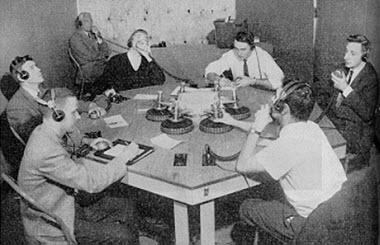At the department’s Air Services School at Ottawa Airport, air traffic control students receive basic training on a unit that simulates actual aircraft movements and control tower operations (from the Department of Transport 1959-1960 Annual Report
In June 1959, Queen Elizabeth and United States President Eisenhower presided at gala ceremonies to declare the St. Lawrence Seaway open for business. Three years later, in September 1962, similar festivities took place at Rogers Pass, B.C. , to officially open the Trans-Canada Highway.
The Department of Transport shared in the honour of these outstanding transportation achievements during an eventful third decade that saw growth and expansion in all areas and rapid development of new communications and transportation technology to meet the department's ever-growing responsibilities.
Aviation
The continuing phenomenal growth of civil aviation and the impending introduction of jet aircraft called for a massive airport construction program. New terminal buildings and runways were built at dozens of sites and existing facilities were enlarged and upgraded. By 1964, all international airports and most other major airports in Canada could accommodate long-range jet aircraft.
More and more trained specialists were required to ensure the safety of air traffic in Canada's increasingly busy skies. In 1959, training for air traffic controllers, meteorologists, radio operators, and telecommunications technicians was centralized in a new Air Services School, at Ottawa International Airport. (The school was the predecessor of what was the Transport Canada Training Institute and is now the NAV CENTRE.)
Technology also played a major role in helping the department cope with the growth in air traffic. The latest electronic aids to navigation – long-range surveillance radars, very high frequency omni radars (VOR), and doppler VOR s – were installed at airports across the country.
Meteorology and telecommunications
Meteorology and telecommunications services were greatly expanded during this period to meet overall transportation needs as well as the requirements of the Distant Early Warning (DEW) and Mid-Canada defence lines constructed in the North in the early years of the Cold War.
The Cold War environment also resulted in the development of emergency measures planning for telecommunications services. The department's Telecommunications and Electronics branch participated in national and international civil defence exercises and staff members attended survival training courses.
Marine
Many technological improvements were introduced in the early '60s to increase the effectiveness and efficiency of marine aids to navigation. Modern diesel equipment began to replace kerosene engines for fog alarm systems and diesel generators were installed at isolated lightstations to improve living conditions for lightkeepers and their families.
A program to convert oil-burning lights to modern automatic types was undertaken and, by 1961, all but 500 of the department's 3,000 lights had been automated. Ship- and shore-based helicopters were used increasingly to service unwatched lights and, in 1965, the first off-shore lightstation with a heliport, at Prince Shoal, Que ., was operated successfully year-round.
In January 1962, a proud tradition began when the fleet arm of the marine services branch was renamed the Canadian Coast Guard. The Coast Guard College, at Point Edward, N.S. , opened in 1965 with an enrolment of 40 navigation and engineering cadets.
New issues
A number of now-familiar issues began to surface in the late '50s and early '60s. Among these were concern for air and marine pollution and the transportation of dangerous goods.
Response by the department included:
- ozone research by the meteorology division for the International Geophysical Year (July 1957 - December 1958);
- establishment of regulations to prevent the pollution of Canadian territorial and inland waters by oil from ships; and
- revision of regulations governing marine shipping of dangerous goods to keep up with the expansion of chemical industries and the many new products and packaging materials coming into use.
The problems of noise abatement and bird control at major airports also arose as traffic at airports grew and jet aircraft became more common.
By the end of the decade, the operations of the Department of Transport were considerably more extensive and efficient than they had been 10 years earlier. To make them so, the department had used a combination of effective planning (often in consultation with international organizations), new technology and training.
